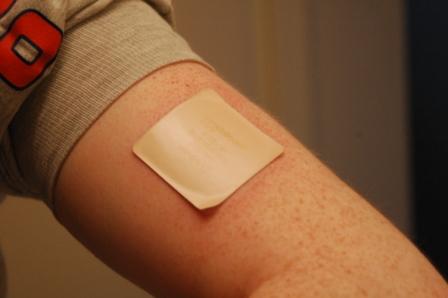Nicotine patch
A nicotine patch is a transdermal patch that releases nicotine into the body through the skin. It is usually used as a method to quit smoking.
General information

Nicotine patches come in several steps so that users can phase out nicotine use; for example, 21, 14, and 7 mg. A cigarette delivers roughly 1 mg of nicotine, so someone who used to smoke a pack (20 cigarettes) per day or more could start with the "step I" 21 mg patch, while someone who smoked less could start with "step II." After several weeks (6 is recommended) at step I, new non-smokers move on to step II (usually two weeks) and step III (two weeks).
For most users, there are few or no short-term health problems associated with using the patch, so users should not rush themselves through the steps; rather, users can phase out nicotine use on their own schedules.
The nicotine patch was invented by New Mexico Tech neuropsychopharmacology professor Dr. Frank T. Etscorn III; the patent was licensed by Ciba-Geigy, later merged with Novartis.
Cost
In the U.S., the nicotine patch costs roughly $20 to $30 per week, although some municipalities, schools or health plans offer subsidized or free nicotine patches. Depending on local tax rates, the cash cost of the patch compares favorably to the cost of cigarettes.
CVS has begun marketing their own brand of nicotine patches under the name of "Nicotine Transdermal System." They are approximately 25 to 30% cheaper than the Nicoderm CQ Patches next to which they are shelved.
In the U.K. nicotine patches cost approximately £15 for a week's supply. For heavy smokers, this compares favourably with cigarettes at £5 for 20 (prices Jan 2007), however light smokers may find that nicotine patches are more expensive than their tobacco habit.
Cost cutting
The main difference between each level is not the amount of nicotine placed between the backing and the adhesive, but the size of the patch. This is due to the nature of the adhesive. For the adhesive to maintain its hold properly, the consistency of it must remain the same, thereby allowing only a specific amount of nicotine through. Yet all the patches regardless of size seem to have the same costs. Buying the strongest patches and cutting them into smaller (weaker) patches is a cost cutting method which the manufacturers warn may lead to nicotine leaking and an unstable delivery, there is no evidence to support or disprove this claim.
Issues
Efficacy
There have been some doubts expressed as to the efficacy of Nicotine Patches, in trials, the success rates of the control groups was significantly lower than would be expected, the presumption being that the low dose control patches made it harder to quit than normal.
Nicotine replacement products (including patches) result in 7% of quitters quitting for at least six months. Alternative such as high intensity counseling increase quitting rates 300% to 22% (see Table 12)
The very government report that states the 22% figure above actually encourages use of nicotine patches, stating the following. "Numerous effective pharmacotherapies for smoking cessation now exist. Except in the presence of contraindications, these should be used with all patients attempting to quit smoking."
Side effects
Death
There are a few recorded cases in which tobacco users died from heart failure after applying multiple patches and then smoking and consuming alcohol at the same time, against doctor's orders.[citation needed] Lawsuits by survivors of such decedents against the decedent's physician and the manufacturers of nicotine patches, cigarettes, and alcohol have generally all been unsuccessful.[citation needed]
Nightmares
Patches are intended to be worn for 24 hours at a time, and then be replaced at the same time every day. However, some individuals wearing the patch while they sleep experience abnormally vivid, erotic, or possibly violent dreams.[citation needed] Within this group, some people become acclimated and are not bothered; others find them completely intolerable. Other people actually enjoy the intense vivid dreaming, experiencing no nightmares or unpleasant dreams, just pleasant dreams of unusual intensity.
For some smokers the solution is simply to wear the patch for approximately 17 hours only, and remove it before bed. There are also several brands which offer sixteen hour patches. However, because the patches take between two and four hours to achieve peak concentration in the body, this can leave the wearer vulnerable to cravings in the morning, particularly if they don't put on the patch immediately when they wake up. For heavier smokers, or smokers whose prior smoking habits included a smoke first thing in the morning or when getting home from work, the twenty-four hour patches can help avoid times of the day where the patch is not delivering enough nicotine and cravings start.
Itching
The nicotine and the adhesive can cause swelling, itching and discomfort in the area covered by the patch. Instructions for using the patch indicate it should be placed at a different location every day. Usually the feeling of itching and mild burning subsides in 30-60 minutes, and is only slightly uncomfortable.
See also
External links
de:Nikotinpflaster nl:Nicotinepleister Template:WikiDoc Sources